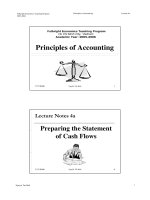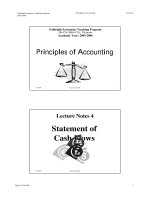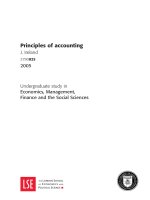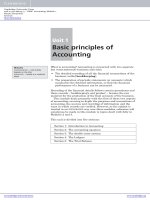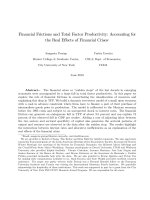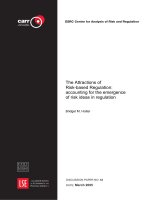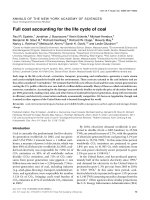Principles of Accounting- Preparing the Statement of Cash Flows
Bạn đang xem bản rút gọn của tài liệu. Xem và tải ngay bản đầy đủ của tài liệu tại đây (179.31 KB, 25 trang )
Fulbright Economics Teaching Program
2005-2006
Principles of accounting
Lecture 4a
Fulbright Economics Teaching Program
Ho Chi Minh City, Vietnam
Academic Year: 2005-2006
Principles of Accounting
7/17/2006
Nguyễn Tấn Bình
1
Lecture Notes 4a
Preparing the Statement
of Cash Flows
7/17/2006
Nguyen Tan Binh
Nguyễn Tấn Bình
2
1
Principles of accounting
Fulbright Economics Teaching Program
2005-2006
Lecture 4a
Cash Flows and Income
The income statement and the statement of
cash flows meet the different demands for
information
The income statement tells us how the firm has
been operating to enrich the owners’ equity
(looking at the results)
The matching rule is applied for revenues and expenses; the
accrual basis of accounting is used to measure the results of
business activities
The statement of cash flows concerns with the net
cash flow generated from business activities
7/17/2006
3
Nguyễn Tấn Bình
Preparing the Statement of Cash Flows
Direct Method
Bo Ho Company
Balance Sheet, December 31 (amounts in thousands)
Current Assets
2004
Cash
16
Receivables
45
Inventory
100
Total Current Assets
161
Fixed Assets, Acc. Cost
581
Accumulated Depreciation(101)
Fixed Assets, net
480
Total Assets
641
2003
25
25
60
$110
330
(110)
220
330
Current Debt
2004
Payables
74
Salaries Payable
25
2003
6
4
Total Current Debt 99
Long-term Debt
125
Owners’ Equity
417
10
5
315
Total Debt & OE 641
330
Notes: During 2004, the firm liquidated some fixed assets for book values and received 10
in cash; it also paid dividends of 19
7/17/2006
Nguyen Tan Binh
Nguyễn Tấn Bình
4
2
Principles of accounting
Fulbright Economics Teaching Program
2005-2006
Lecture 4a
Direct Method
Bo Ho Company
Income Statement ($1000)
December 31, 2004
Revenue
Expenses:
Cost of Goods Sold
Salaries Expense
Depreciation Expense
Interest Expense
Total Expenses
Earnings Before Tax
Corporate Income Tax
Net Income
7/17/2006
$200
100
36
17
4
157
43
20
$ 23
5
Nguyễn Tấn Bình
Direct Method
Bo Ho Company
Statement of Cash Flows ($1000)
December 31, 2004
CASH FLOW FROM OPERATING:
Receipts from Customers
Payments
Suppliers
Salaries
Interest
Taxes
Total Payments
Net Cash Flow from Operating (I)
7/17/2006
Nguyen Tan Binh
Nguyễn Tấn Bình
$ 180
$ 72
15
4
20
(111)
$ 69
6
3
Principles of accounting
Fulbright Economics Teaching Program
2005-2006
Lecture 4a
Direct Method
Bo Ho Company
Statement of Cash Flows ($1000)
December 31, 2004 (cont.)
CASH FLOW FROM INVESTING:
Payments for Purchases of Fixed Assets
Collections from Liquidation of Fixed Assets
Net Cash Flow from Investing (II)
7/17/2006
$(287)
10
(277)
7
Nguyễn Tấn Bình
Direct Method
Bo Ho Company
Statement of Cash Flows ($1000)
December 31, 2004 (cont.)
CASH FLOW FROM FINANCING:
Long term Borrowing
Stock Issue
Dividends Paid
Net Cash Flow from Financing (III)
TOTAL NET CASH FLOW = I+II+III (decrease)
Cash Balance, December 31, 2003
Cash Balance, December 31, 2004
7/17/2006
Nguyen Tan Binh
Nguyễn Tấn Bình
$120
98
(19)
199
(9)
25
$ 16
8
4
Fulbright Economics Teaching Program
2005-2006
Principles of accounting
Lecture 4a
Direct Method
Step 1: Look at the change in the balance
from the beginning to the end of period
These numbers are often shown at the end of
the cash flow statement
•
•
Total net cash flow + the beginning cash
balance = the ending cash balance
Or, the ending cash balance – the beginning
cash balance = total net cash flow
7/17/2006
9
Nguyễn Tấn Bình
Direct Method
In our example, cash balance reduces by
$9,000
Operating activity during period provides $69,000
Investing activity uses $277,000
Financing activity generates $199,000
($69,000 + 199,000 – 277,000 = - $9,000)
It tells us, the firm shows a profit but its cash is
decreasing
7/17/2006
Nguyen Tan Binh
Nguyễn Tấn Bình
10
5
Fulbright Economics Teaching Program
2005-2006
Principles of accounting
Lecture 4a
Changes in Accounting Equation
The accounting equation can be rearranged:
Cash = Liabilities + OE – Non-cash Assets
or
∆Cash = ∆Liabilities + ∆OE – ∆Non-cash Assets
Any change (∆) in non-cash items (liabilities, owners’
equity, or assets) must be accompanied by a change
in cash to keep the equation balance
If a non-cash asset changes, how will it affect cash?
7/17/2006
Nguyễn Tấn Bình
11
Changes in Accounting Equation
(cont.)
The statement of cash flow concerns with
changes in non-cash accounts as a means to
explain why and how the cash balance
changes during the accounting period
Changes in Cash = Changes in all Non-cash
Accounts
or
What happens to Cash? = Why does it happen?
7/17/2006
Nguyen Tan Binh
Nguyễn Tấn Bình
12
6
Fulbright Economics Teaching Program
2005-2006
Principles of accounting
Lecture 4a
Cash Equation
Assets = Liabilities + Owners’ Equity
Current Assets + Fixed Assets = Liabilities +
Owners’ Equity
Cash + Receivables + Inventory = Liabilities +
Owners’ Equity – Fixed Assets
Cash = Liabilities + OE – FA – Receivables –
Inventory
A change in Liabilities or Owners’ Equity leads to a positive
change in Cash
A change in Assets leads to a negative change in Cash
7/17/2006
Nguyễn Tấn Bình
13
Calculating Cash Flow from
Operating Activity
Receipts from customers are the largest
inflow from operating activity
Disbursements for merchandise purchases
and operating expenses are the largest
outflow to operating activity
Inflows minus (-) outflows equal the net
cash flow generated from (or used by)
operating activity
7/17/2006
Nguyen Tan Binh
Nguyễn Tấn Bình
14
7
Fulbright Economics Teaching Program
2005-2006
Principles of accounting
Lecture 4a
From Amounts on the Income Statement to
Items on the Statement of Cash Flows
Accountants often calculate cash flows from
income statement items
Some accountants use the balance sheet with their
experiences and additional information to
determine changes in the balance sheet and
calculate cash flow items
However, most of corporate accounting systems
cannot provide detailed information to follow this
way
7/17/2006
Nguyễn Tấn Bình
15
From Amounts on the Income Statement to
Items on the Statement of Cash Flows (cont.)
In our example, $180,000 is collected from customers.
This amount is determined as follows:
Revenue
Beginning Receivables
Total Receivables
Ending Receivables
Collections during Period
$200,000
25,000
$225,000
45,000
$180,000
=======
Revenue
Decrease (Increase) in Receivables
Collections during Period
(+)
(=)
(-)
(=)
$200,000
(20,000)
$180,000
=======
Or
Remember that an increase in receivables means collections < revenue
7/17/2006
Nguyen Tan Binh
Nguyễn Tấn Bình
16
8
Fulbright Economics Teaching Program
2005-2006
Principles of accounting
Lecture 4a
From Amounts on the Income Statement to
Items on the Statement of Cash Flows (cont.)
The difference between the cost of goods sold and the amount
paid to suppliers can be determined by looking at inventory and
payables
(+)
(=)
(-)
(=)
Ending Inventory
Cost of Goods Sold
Merchandise during Period
Beginning Inventory
Merchandise Purchased during Period
$100,000
100,000
$200,000
(60,000)
$140,000
=======
Beginning Payables
(+)
(=)
(-)
(=)
$
Merchandise Purchased during Period
Total Payables
Ending Payables
Amount Paid to Suppliers
7/17/2006
Nguyễn Tấn Bình
6,000
140,000
$146,000
(74,000)
$ 72,000
=======
17
From Amounts on the Income Statement to
Items on the Statement of Cash Flows (cont.)
Calculations on the previous slide for the
amount paid to suppliers can be summarized as
follows:
Cost of Goods Sold
Increase (Decrease) in Inventory
Decrease (Increase) in Payables
Amount Paid to Suppliers
7/17/2006
Nguyen Tan Binh
Nguyễn Tấn Bình
$100,000
40,000
(68,000)
$72,000
18
9
Fulbright Economics Teaching Program
2005-2006
Principles of accounting
Lecture 4a
From Amounts on the Income Statement to
Items on the Statement of Cash Flows (cont.)
The salaries paid can be determined by salaries expense and
salaries payable
Beginning Salaries Payable
(+) Salaries Expense during Period
(=) Total Salaries Payable
(-) Ending Salaries Payable
(=) Salaries Paid
$ 4,000
36,000
$ 40,000
(25,000)
$ 15,000
Or,
Salaries Expense during Period
Decrease (Increase) in Salaries Payable
Salaries Paid
7/17/2006
$ 36,000
(21,000)
$ 15,000
Nguyễn Tấn Bình
19
From Amounts on the Income Statement to
Items on the Statement of Cash Flows (cont.)
Note that in our example, both interest payable
and corporate tax payable have a zero balance at
the beginning and the ending of period
It means the total interest expense and
tax have been accrued and paid off, so
the cash flow equals the expenses,
namely, $4,000 interest paid, and
$20,000 tax paid
7/17/2006
Nguyen Tan Binh
Nguyễn Tấn Bình
20
10
Principles of accounting
Fulbright Economics Teaching Program
2005-2006
Lecture 4a
Comparing the Income Statement
and the Statement of Cash Flows
Since revenues and expenses are recognized
on the accrual basis of accounting, they are
inevitably related to the balance sheet
accounts
The cash impacts on income statement accounts
are balanced by the related balance sheet
accounts
The balance sheet approach is based on the
net income, then adjusted for changes in the
balance sheet accounts
7/17/2006
21
Nguyễn Tấn Bình
Comparing the Income Statement and
the Statement of Cash Flows (cont.)
Summary of the balance sheet approach:
Changes in
Non-cash Assets
Less Increase
or
Plus Decrease
Negative
Impact
Amounts on
Income Statement
Changes in
Liabilities &
Owners’ Equity
7/17/2006
Nguyen Tan Binh
Amounts on
Balance Sheet
Plus Increase
or
Less Decrease
Nguyễn Tấn Bình
22
11
Fulbright Economics Teaching Program
2005-2006
Principles of accounting
Lecture 4a
Comparing the Income Statement and
the Statement of Cash Flows (cont.)
Remember, regardless plus or minus an
increase or a decrease, any change in non-cash
assets, liabilities, or owners’ equity is always
accompanied by a change in cash to keep the
accounting equation balance
∆Cash = ∆Liabilities + ∆Owners’ Equity
– ∆Non-cash Assets
7/17/2006
23
Nguyễn Tấn Bình
Comparing the Income Statement and
the Statement of Cash Flows (cont.)
The common adjustments to transfer the amounts on the
income statement into cash flow items:
Income Statement
Non-cash Assets
Liabilities
Revenue
Cost of Goods Sold
Salaries Expense
Rental Expense
Insurance Expense
Depreciation Expense
Amortization Expense
Receivables
Purchases during Period
Prepaid Salaries
Prepaid Rental
Prepaid Insurance
Fixed Assets
Intangible Assets
Deferred Revenue
Payables
Salaries Payable
Rental Payable
Insurance Payable
7/17/2006
Nguyen Tan Binh
Nguyễn Tấn Bình
24
12
Fulbright Economics Teaching Program
2005-2006
Principles of accounting
Lecture 4a
Calculating Cash Flows from
Investing and Financing Activities
Cash Flow from Investing
Disbursements for fixed asset purchases and receipts
from fixed asset liquidations
Cash Flow from Financing
Receipts from borrowing or stock issue, and
disbursements for debt payments or equity payment
to shareholders
7/17/2006
Nguyễn Tấn Bình
25
Calculating Cash Flows from
Investing and Financing Activities (cont.)
The main idea of investing and
financing activities is the position of
investments in fixed assets, and the
position of fund mobilization and
repayment
7/17/2006
Nguyen Tan Binh
Nguyễn Tấn Bình
26
13
Fulbright Economics Teaching Program
2005-2006
Principles of accounting
Lecture 4a
Calculating Cash Flows from
Investing and Financing Activities (cont.)
Analyze items on balance sheet for investing
and financing activities:
An increase in cash (an inflow) from:
An increase in liabilities or owners’ equity
A decrease in non-cash assets
A decrease in cash (an outflow) from:
A decrease in liabilities or owners’ equity
An increase in non-cash assets
7/17/2006
Nguyễn Tấn Bình
27
Calculating Cash Flows from
Investing and Financing Activities (cont.)
A change in fixed assets usually is
A purchase of fixed assets
A liquidation of fixed assets
Depreciation expense
Net Change = Purchases – Sales – Depr. During Period
Data on Bo Ho Company:
Net Change:
Sales (at Book Value):
Depreciation during Period:
Purchases during Period:
7/17/2006
Nguyen Tan Binh
260 (=480 – 220)
10
17
287 (=260+10+17)
Nguyễn Tấn Bình
28
14
Fulbright Economics Teaching Program
2005-2006
Principles of accounting
Lecture 4a
Calculating Cash Flows from
Investing and Financing Activities (cont.)
A change in owners’ equity usually is
A new stock issue
Net income
Dividends
Net Change = New Issue + Net Income – Dividends
Data on Bo Ho Company
Net Change in OE:
Net Income during 2004:
Dividends Paid during 2004:
New Stock Issue:
7/17/2006
102 (= 417 – 315)
23
19
98 (=102 – 23 + 19)
Nguyễn Tấn Bình
29
Non-cash Investing and Financing
Activities
Non-cash activities have no impact on cash,
and hence, do not appear on the statement of
cash flows
Remember, cash flows from investing and financing
activities are prepared under the direct method; that is,
they are actually received and paid
Readers still want to know this information
These items will be shown as endnotes to the
statement of cash flows, or on a separate statement
7/17/2006
Nguyen Tan Binh
Nguyễn Tấn Bình
30
15
Fulbright Economics Teaching Program
2005-2006
Principles of accounting
Lecture 4a
Preparing the Statement of Cash Flows
Indirect Method
In addition to the direct method of
calculating cash flows from operations, the
indirect method is also used
The indirect method proves to be better in
valuation of income quality
The indirect method adjusts net income to
account the net cash flow from operating
Through adjustments, impacts on net cash flow
from operating are more clearly shown
7/17/2006
Nguyễn Tấn Bình
31
Adjusting Net Income to Account the Net
Cash Flow from Operating
The indirect method starts with net
income
Plus and minus changes in current assets and
current debt (which make net income and net
cash flow different)
If a firm uses the direct method, the
national accounting standard commission
often asks for an additional use of indirect
method
7/17/2006
Nguyen Tan Binh
Nguyễn Tấn Bình
32
16
Principles of accounting
Fulbright Economics Teaching Program
2005-2006
Lecture 4a
Adjusting Net Income to Account the Net
Cash Flow from Operating (cont.)
Adjustments include
Depreciation is added back to net income because it
reduces income on the income statement, but cash is not
actually disbursed
An increase in current (non-cash) assets leads to a
decrease in cash from operating, so it is adjusted by
subtracting from net income
A decrease in current (non-cash) assets leads to an
increase in cash from operating, so it is adjusted by
adding to net income
7/17/2006
Nguyễn Tấn Bình
33
Adjusting Net Income to Account the Net
Cash Flow from Operating (cont.)
Adjustments include (cont.)
An increase in liabilities leads to an
increase in cash from operating, so it is
adjusted by adding to net income
A decrease in liabilities leads to a decrease
in cash from operating, so it is adjusted by
subtracting from net income
7/17/2006
Nguyen Tan Binh
Nguyễn Tấn Bình
34
17
Fulbright Economics Teaching Program
2005-2006
Principles of accounting
Lecture 4a
Adjusting Net Income to Account the Net
Cash Flow from Operating (cont.)
The general principle of addition and
subtraction to adjust net income in the indirect
method is as same as in the direct method,
namely, to adjust line by line on the income
statement
Remember the cash equation
∆Cash = ∆Liabilities + ∆Owners’ Equity –
∆Non-cash Assets
7/17/2006
35
Nguyễn Tấn Bình
Adjusting Net Income to Account the Net
Cash Flow from Operating (cont.)
Calculating cash flow from operating for Bo Ho Company
Net Income
$23
Adjustments for net income to calculate
cash flow from operating
Depreciation
Increase in Accounts Receivable
Increase in Inventory
Increase in Accounts Payable
Increase in Salaries Payable
Net Impact (increase and decrease)
Net Cash Flow from Operating
7/17/2006
Nguyen Tan Binh
Nguyễn Tấn Bình
$ 17
(20)
(40)
68
21
46
$ 69
36
18
Fulbright Economics Teaching Program
2005-2006
Principles of accounting
Lecture 4a
Adjusting Net Income to Account the Net
Cash Flow from Operating (cont.)
As discussed, depreciation is the allocation of the
historical cost over the future accounting periods
Depreciation is not a disbursement flow; it is a noncash expense
Depreciation is added back to net income to account
the net cash flow from operating, simply because it
has been subtracted when we calculating net income
on the income statement. Deprecation is also not a
cash receipt flow
7/17/2006
37
Nguyễn Tấn Bình
Adjustments
Addition of non-cash losses (or expenses)
Depreciation (for fixed assets), amortization (for intangible assets), depletion
(for natural resources)
Losses from non-operating activity
Subtraction of non-cash profits (or revenues)
Profits from non-operating activity
Adjustments for changes in current assets and current debt
(generally called working capital) related to operating
Changes in
current assets
# Less Increase
# Plus Decrease
7/17/2006
Nguyen Tan Binh
Changes in
current debt
@ Plus Increase
@ Less Decrease
Nguyễn Tấn Bình
38
19
Fulbright Economics Teaching Program
2005-2006
Principles of accounting
Lecture 4a
Adjustments (cont.)
Profits (losses) from non-cash operating do not
belong to the firm’s main operating activity, but
are shown on the income statement, and hence,
affect the net income
These profits (losses) should be subtracted from
(added to) net income, because they have been
recorded in the other activity (investing and
financing)
These profits (losses) are reflected in the other activities
(investing or financing), so they should be adjusted to
avoid from being double recorded on the same statement
of cash flows
7/17/2006
Nguyễn Tấn Bình
39
Adjustments (cont.)
Ben Thanh Company sells a piece of
land for 50 million in cash; its
acquisition cost is 75 million; the firm
has a loss of 25 million
How does this loss affect the cash
flow from operating on the statement of
cash flow?
7/17/2006
Nguyen Tan Binh
Nguyễn Tấn Bình
40
20
Fulbright Economics Teaching Program
2005-2006
Principles of accounting
Lecture 4a
Adjustments (cont.)
The firm’s net income has included the 25
million loss, but this is not an operating activity
The cash flow of 50 million (with the loss
imbedded) is shown in the category of cash flow
from investing
The 25 million loss should be added back to net
income as an adjustment, to avoid double
recording on the statement of cash flow
7/17/2006
Nguyễn Tấn Bình
41
More Discussion on the Statement
of Cash Flows
Two items usually shown on the statement
of cash flow in the indirect method:
Profits or losses from sales of
fixed assets (investing)
Profits or losses from debt
payment before due (financing)
7/17/2006
Nguyen Tan Binh
Nguyễn Tấn Bình
42
21
Fulbright Economics Teaching Program
2005-2006
Principles of accounting
Lecture 4a
Profits/losses from sales of fixed
assets
As discussed, these profits (losses)
should be subtracted from (or added to)
the net income to adjust the net cash
flow from operating
They are not from operating, but included
in net income, and hence, should be
subtracted
7/17/2006
Nguyễn Tấn Bình
43
Profits/losses from debt payment
before due
Borrowing and paying debt are a
financing activity, but the profits (losses)
from debt payment before due have been
shown in the net income
These profits (losses) should be adjusted as
same as those from sales of fixed assets
7/17/2006
Nguyen Tan Binh
Nguyễn Tấn Bình
44
22
Fulbright Economics Teaching Program
2005-2006
Principles of accounting
Lecture 4a
Statement of Cash Sources and Uses
Bo Ho Company
The statement of cash sources and uses is the precursor of the
statement of cash flows; it looks like a “random collection” of
plus and minus signs (changes in the balance sheet items)
Simply
A change in liabilities and owners’ equity, or a
decrease in assets generates cash
A decrease in liabilities and owners’ equity, or an
increase in assets uses cash
7/17/2006
45
Nguyễn Tấn Bình
Statement of Cash Sources and Uses
Bo Ho Company
Cash Sources
- Increase in Accounts Payable
- Increase in Salaries Payable
- Increase in Long-term Debt
- Increase in Owners’ Equity
- Decrease in Cash Balance
Total
Cash Uses
- Increase in Accounts Receivable
- Increase in Inventory
- Increase in Fixed Assets (net)
Total
7/17/2006
Nguyen Tan Binh
Nguyễn Tấn Bình
68
21
120
102
9
320
20
40
260
320
46
23
Principles of accounting
Fulbright Economics Teaching Program
2005-2006
Lecture 4a
Statement of Cash Sources and Uses
Bo Ho Company
Cash Sources
- Increase in Accounts Payable
- Increase in Salaries Payable
- Increase in Long-term Debt
- Increase in Owners’ Equity
- Decrease in Cash Balance
Total
Cash Uses
- Increase in Accounts Receivable
- Increase in Inventory
- Increase in Fixed Assets (net)
Total
68
21
120
102
9
320
20
40
260
320
Transactions are recorded on the basis of
double-entry accounting, hence, the cash
sources and uses always equal
7/17/2006
47
Nguyễn Tấn Bình
Nothing to worry about the cash flow statement.
It is only the matter of the two operations
Subtraction!
Addition!!
7/17/2006
Nguyen Tan Binh
Addition!
Subtraction!!
Nguyễn Tấn Bình
48
24
Principles of accounting
Fulbright Economics Teaching Program
2005-2006
Lecture 4a
References
Horngren – Sundem – Elliott
Introduction to Financial Accounting, 8th Edition, Prentice Hall, 2002.
Stickney – Weil
Financial Accounting, 8th Edition, The Dryden Press, 1997.
Nguyen Tan Binh
Ke toan quan tri, Nha Xuat ban Dai hoc Quoc gia Tp.HCM, 2003
7/17/2006
Nguyen Tan Binh
Nguyễn Tấn Bình
49
25

